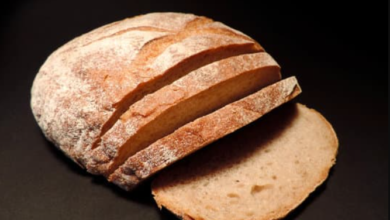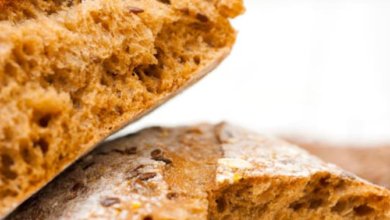Whole Wheat Bread Vs Rye Bread: The Benefits And Drawbacks
What To Know
- This comprehensive guide delves into the nutritional showdown between whole wheat bread and rye bread, unraveling their distinct characteristics and helping you make an informed choice for your next loaf.
- Rye bread tends to be denser and moister than whole wheat bread due to the water-absorbing properties of rye flour.
- Whether you prefer the nutty flavor of whole wheat bread or the sour tang of rye bread, the world of bread offers an array of nutritious and delectable choices.
In the realm of bread, two titans stand tall: whole wheat bread and rye bread. Both boast nutritional prowess, leaving bread enthusiasts torn between their wholesome attributes. This comprehensive guide delves into the nutritional showdown between whole wheat bread and rye bread, unraveling their distinct characteristics and helping you make an informed choice for your next loaf.
Nutritional Profile
Whole Wheat Bread
Whole wheat bread is crafted from the entire wheat kernel, including the nutrient-rich bran, germ, and endosperm. This composition bestows upon it an impressive nutritional profile:
- High in Fiber: Whole wheat bread is a formidable source of dietary fiber, essential for digestive health and satiety.
- Abundant in Vitamins and Minerals: It teems with vitamins B1, B2, B3, and E, along with minerals such as iron, magnesium, and zinc.
- Rich in Antioxidants: Whole wheat bread contains antioxidants like lignans and ferulic acid, which combat free radical damage.
Rye Bread
Rye bread derives its unique taste and texture from rye flour, which is made from ground rye berries. It exhibits a distinct nutritional profile:
- Lower in Calories: Compared to whole wheat bread, rye bread contains slightly fewer calories per slice.
- Excellent Source of Soluble Fiber: Rye bread is particularly rich in soluble fiber, which helps lower cholesterol levels and promote blood sugar control.
- Abundant in B Vitamins: It is a good source of vitamins B1, B2, and B3, essential for energy metabolism and nerve function.
Health Benefits
Whole Wheat Bread
- Improved Heart Health: The fiber content in whole wheat bread helps reduce cholesterol levels, lowering the risk of heart disease.
- Enhanced Digestion: Its high fiber content promotes regular bowel movements and prevents constipation.
- Potential for Weight Management: Whole wheat bread is more satiating than white bread, helping you feel fuller for longer.
Rye Bread
- Reduced Cholesterol Levels: The soluble fiber in rye bread effectively binds to cholesterol, preventing its absorption into the bloodstream.
- Improved Blood Sugar Control: Rye bread’s low glycemic index helps regulate blood sugar levels, making it a suitable choice for individuals with diabetes.
- Anti-Inflammatory Properties: Rye bread contains compounds that may possess anti-inflammatory effects, potentially reducing inflammation throughout the body.
Taste and Texture
Whole Wheat Bread
- Nutty Flavor: Whole wheat bread has a slightly nutty and earthy flavor, imparted by the presence of the bran.
- Chewy Texture: Its high fiber content contributes to a chewy and dense texture.
Rye Bread
- Sour Tang: Rye bread is characterized by a distinctive sour tang, resulting from the fermentation process involving rye sourdough.
- Dense and Moist: Rye bread tends to be denser and moister than whole wheat bread due to the water-absorbing properties of rye flour.
Versatility
Both whole wheat bread and rye bread offer versatility in culinary applications.
- Whole Wheat Bread: Ideal for sandwiches, toast, and as a base for pizza crust.
- Rye Bread: Excellent for open-faced sandwiches, grilled cheese, and as a companion to soups and stews.
Which Bread Is Right for You?
The choice between whole wheat bread and rye bread ultimately depends on your individual preferences and health goals.
- Whole Wheat Bread: An excellent choice for individuals seeking a high-fiber, nutrient-rich bread that promotes heart health and digestive well-being.
- Rye Bread: A suitable option for those seeking a bread with lower calories, soluble fiber, and potential anti-inflammatory properties.
Beyond the Bread
In addition to whole wheat and rye bread, there are numerous other bread varieties with unique nutritional profiles.
- Sourdough Bread: Fermented with wild yeast and bacteria, sourdough bread is known for its tangy flavor and digestibility.
- Sprouted Grain Bread: Made from sprouted grains, this bread is rich in nutrients and enzymes.
- Gluten-Free Bread: Suitable for individuals with celiac disease or gluten intolerance.
Wrap-Up: Embracing Bread’s Nutritional Diversity
Whether you prefer the nutty flavor of whole wheat bread or the sour tang of rye bread, the world of bread offers an array of nutritious and delectable choices. By understanding the distinct nutritional attributes of each variety, you can make an informed decision that aligns with your health and taste preferences.
Frequently Asked Questions
1. Is whole wheat bread healthier than rye bread?
Both whole wheat bread and rye bread offer health benefits, but whole wheat bread is generally considered healthier due to its higher fiber content and abundance of vitamins and minerals.
2. Which bread is better for weight loss?
Both whole wheat bread and rye bread can support weight loss as they are more satiating than white bread. However, whole wheat bread may have a slight edge due to its higher fiber content.
3. Is rye bread good for cholesterol?
Yes, rye bread is a good source of soluble fiber, which helps reduce cholesterol levels and promotes heart health.
4. What is the difference between rye flour and whole wheat flour?
Rye flour is made from ground rye berries, while whole wheat flour is made from the entire wheat kernel, including the bran, germ, and endosperm. Rye flour has a lower gluten content than whole wheat flour, resulting in a denser and moister texture.
5. How do I choose the best bread?
When selecting bread, look for varieties that are made with whole grains, have a high fiber content, and are low in added sugars and sodium.



